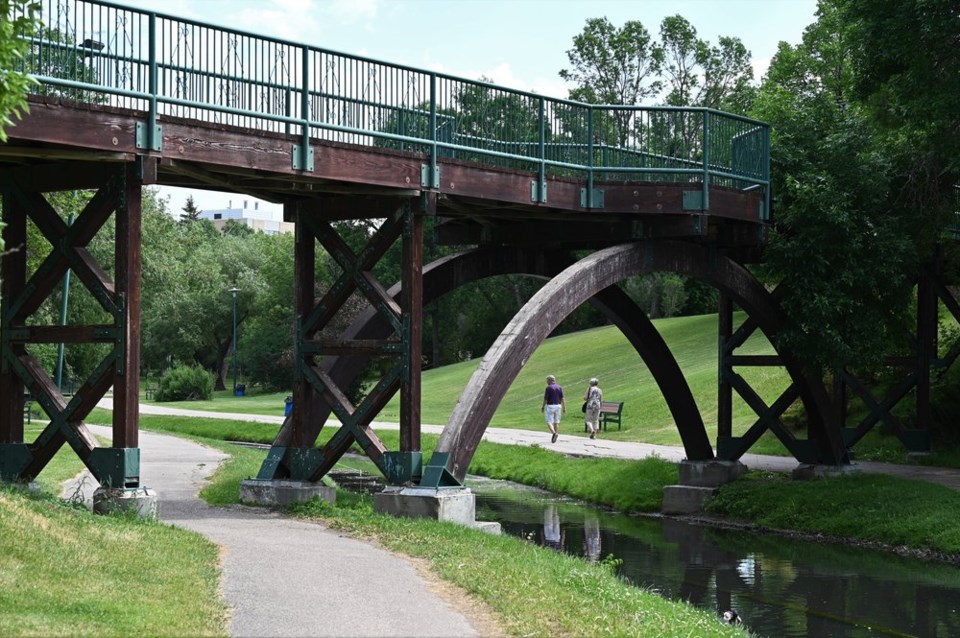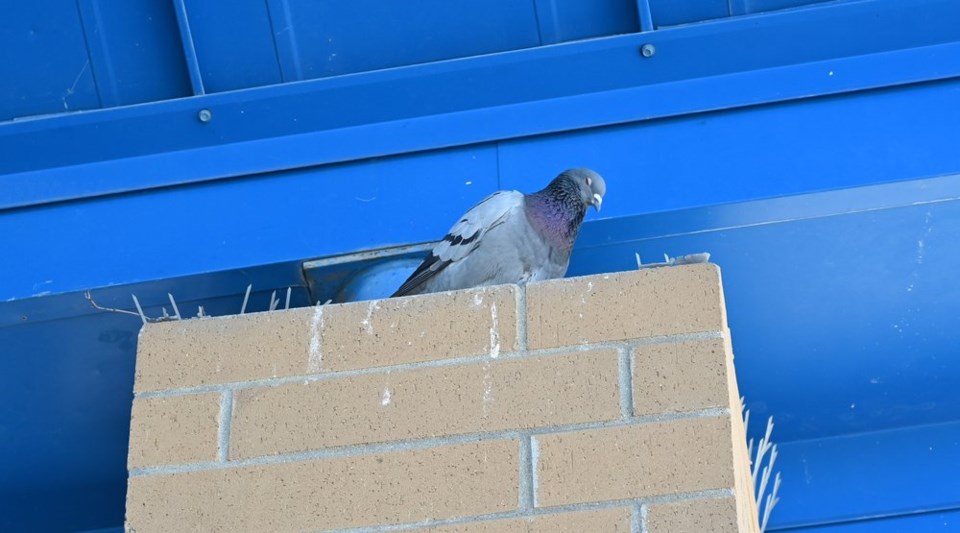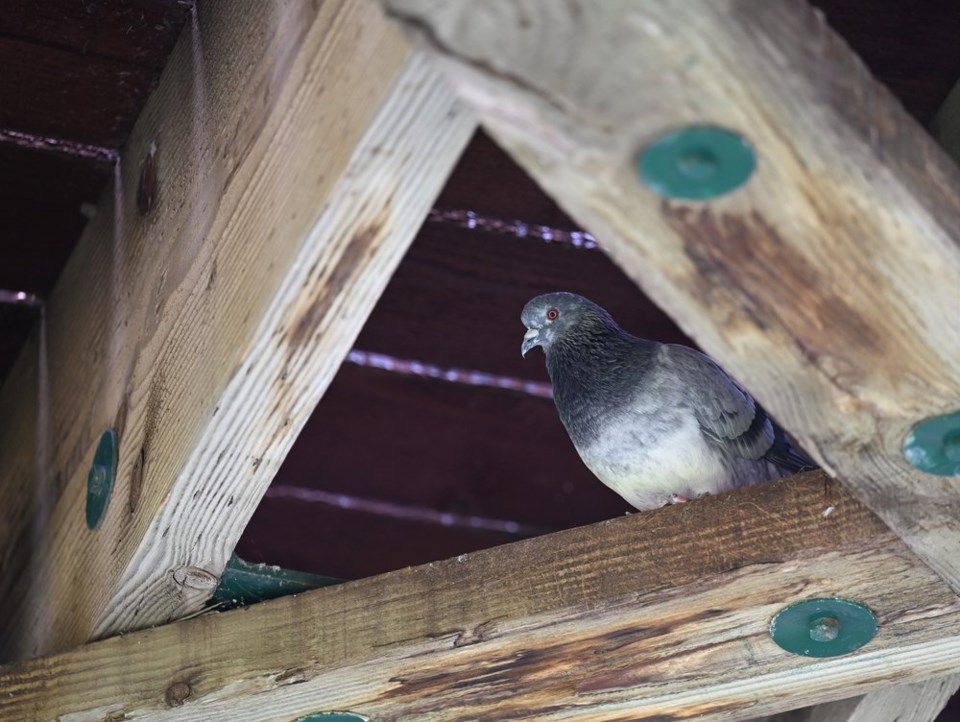It is a plan designed to force a change in scenery for some of Moose Jaw’s pigeons but if the birds were able to understand the alternative it would likely have them perched on Mayor Clive Tolley’s office windowsill cooing in approval.
At a recent Council meeting Councillor Heather Eby asked what the City’s plans were regarding pigeon control to which she received an answer the City was in fact working with a company to fix the problem.
But with that said it is not a story about poisoning and eradication but rather one of humanely encouraging the pigeons to move along.
“It’s not just about kill, kill, kill. There has got to be other alternatives and other solutions that you can do. That way you don’t raise mass hysteria. You aren’t out killing things and ruining food chains and all kinds of stuff,” Cory Oakes Operations Manager for City of Moose Jaw Parks and Recreation told MJ Independent.
Oakes said it is a bit of a mindset change when it comes to dealing with animals considered to be pests by many. A move to create barriers to have animals move to other places where they are not seen as a problem rather than euthanizing them. A move backed up by research.
“It has been proven based on the research to the people I have spoken to, you can move them away and they will find other areas. They can go to high density trees for example and go to other areas that are a lot less invasive and you won’t even notice them,” he said.
The City has identified three areas where pigeons and their associated droppings - Crescent Park Bridge, Kinsmen Sportsplex and the City yard’s bus barns - are seen as a nuisance and non-lethal methods to disperse them will be used.
“If we get them out of these highly visible areas they will just disappear and drop out of people’s minds,” Oakes said.
To accomplish this the City is working on setting up a pigeon control program at the three City facilities with the use of non-lethal methods.
“There will be no harm to any of the pigeons. It will just be some deterrents and devices.”
The non-lethal methods will include cleaning, physical, visual and audio barriers.

At Crescent Park the plan calls for the installation of nylon netting to prevent the pigeons from accessing the under structure of the bridge. Additionally visual deterrents would also be instilled that over time would also help with reduce the pigeon numbers.
At the Kinsmen Sportsplex there will also be visual deterrents as well as physical deterrents to eliminate pigeons’ ability to roost at the facilities entrance.
At the City’s bus barns there will be visual and audio deterrents.
Cleaning will also occur at all three locations in order to remove the pheromones pigeons deposit that tells and encourages other pigeons it is a place to roost and nest.
“The pheromones of the bird is what brings them back for things like nesting every year.”
Safety is another major factor in going the non-lethal route because there are children and other animals in two of the areas the City is planning to encourage the pigeons to leave.
“We want to make everything environmentally friendly, safe for kids and animals alike. But the big goal would be for pigeon deterrent. Not allowing them an area to roost, not allowing them an area to sit and congregate and their pheromones will be removed that helps remove them from the site,” Oakes said.
“Then they just don’t come back every year.”
Oakes said although more expensive initially then the more traditional euthanizing and poisoning of problem pigeons the long term cost savings of a non-lethal approach are better.
“The investment out front pays out over time. The vinyl netting lasts 10 to 15 years. These optical gel pucks last 10 to 15 years. The spikes. The audio equipment is going to be placed inside so it is going to be protected so it can last forever,” he said.
“Everything up front is going to be a little bit more but it is no different than buying poison or having someone trap them year after year after year.”
Making it difficult for pigeons to congregate and sit makes it more likely they will move on.
“With this stuff they won’t even be able to sit. If they have nowhere to rest, they can’t mate, they can’t do anything. They have got to go somewhere else. So they just have to spread out and they disappear,” Oakes said.
“It is easier for maintenance. It is more aesthetically pleasing. You’re not thinking you are going to get pooped on walking under the bridge and you are not going to see all of that accumulation of bird poop and like that. The same at the front door of the Kinsmen (Sportsplex). It keeps the buses cleaner (cutting down on washing costs) when we do it in the bus barns.”
The goal is to alter the habits of pigeons so they are not seen as a problem.
“Our goal is basically we are going to change their habits. So instead of them coming back to that bridge and leaving all of that poop all over the place they will spread out a little bit more over the park. You will see the odd pigeon here and there but you won’t see ten pigeons sitting in one area anymore.”

Non-Lethal Approach Not Just For Pigeons
Public perception wise the non-lethal approach has benefits as there is less negative feedback. It is move the City has made when it comes to beavers from a lethal to a non-lethal approach.
“It is like beavers you can go out there and kill but the perception is just horrible a gun out there with a gun shooting beavers. Of course they call them swimming rats, flying rats, everything is a rat…it is like with beavers you move one family and within weeks a new family moves in,” he said adding the City has moved to a live and let live approach.
When the City has to cut down trees instead of grinding it all into mulch portions of the trees are put where the beavers are and they take them for food instead of cutting down trees.
“We take the trees and cut them into large sections and place them in their high feeding areas and sure enough they will take all of that wood and they won’t touch the big trees.”
Beavers will still nibble on small branches and take the odd tree but the results are a significant decrease in the number of trees beavers cut down.
If beavers are a problem the City is no longer hiring someone to shoot them but are now relocating them to other areas where they are no longer a problem.
When it comes to beavers the City also works in ways, such as culvert placements and sizes, by designs to help prevent beavers from being able to block them off to create a dam.
“We just changed our mindset. We just try to work with the animals and change their habits.”

Animal Lover Praises City’s Actions
The City’s non-lethal animal control methods has the endorsement of likely the most well known animal rehabber for pigeons in the province - Jan Shadick wildlife rehabilitator and director of Living Sky Wildlife Rehabilitation in Saskatoon.
“Brilliant, that is absolutely brilliant,” Shadick told MJ Independent in a telephone interview.
“That is brilliant that a city is being progressive and environmentally sound in the management of the different wildlife in the city I think that is just fantastic,” she said, adding “I am very impressed. Moose Jaw is doing fantastic.”
Shadick said she would like to share what Moose Jaw’s approach is with other municipalities. Municipalities that use “lethal solutions” she sees as often cruel and unnecessary.
“They need to get the word out to a lot of towns and cities in this province because the lethal response to experiencing a problem with a wild animal is unbelievably quick around here and it would be fantastic for us to figure out we actually need these animals and find different ways of co-existing,” she said.
Shadick is well known for raising concerns about how the City of Saskatoon handles their pigeon problem. She got involved because not only her concern for animals but also because many of the pigeons, and other birds, effected by Avitrol which is a nerve effecting agent (poison) ending up in her care.
Avitrol is a nerve agent that effects not only the intended target birds (pigeons, starlings, blackbirds, sparrows, crows and house sparrows) but all vertebrates.
The product is controversial with the manufacturer, Avitrol Corp, stating it is not a poison but a deterrent. The deterrent effect is that it causes birds to artificially emit distress and alarm cries and visual displays used by their species when they are frightened or injured. The behaviour is suppose to scare off the flock who will think there is predator danger in the area.
For its detractors Avitrol is in fact a poison and designed to do one thing - kill birds. Opponents point out the effect on pigeons is not just erratic flying into buildings but also convulsions, inability to control their nervous functions and alarming distress calls and cries.
Avitrol is a nerve agent can effect all vertebrates including humans.
For Shadick numerous pigeons and other birds end up at her animal rescue after ingesting Avitrol.
She recommends measures the City is going to use as well as other methods such as bait treated with OvoControl P amongst other non lethal control methods.
OvoControl P is a product which can be likened to birth control pills for target birds and over time the flock is reduced by natural death as no new chicks are born.
“This way the flock is naturally reduced in numbers.”
Shadick says she is no expert but if the City were to ask for more help or information on other potential non-lethal control methods she would be open to help.




